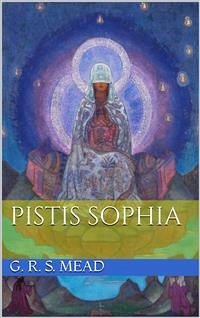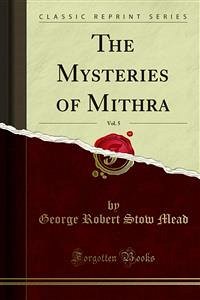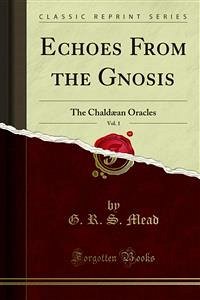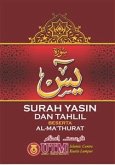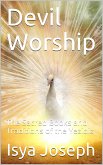Pistis Sophia (Πίστις Σοφία) is a gnostic text discovered in 1773, possibly written between the 3rd and 4th centuries AD. The existing manuscript, which some scholars place in the late 4th century, relates one Gnostic group's teachings of the transfigured Jesus to the assembled disciples, including his mother Mary, Mary Magdalene, and Martha.
The story of Pistis Sophia’s fall and restoration (chapters 29-82) dominates much of Books 1 & 2. She dwells in the thirteenth aeon, is tricked into leaving her aeon and descending into Chaos, has her light-power stolen, and is not allowed to return to her place until Jesus ascends through the aeons. She recites many repentances and prayers, and is repeatedly persecuted by wicked archontic beings before being allowed to wait just outside of the thirteenth aeon for restoration.
---------
Similmente a molte altre opere gnostiche il Pistis Sophia andò perduto con l'estinguersi dello gnosticismo. Una versione del testo fu trovata a Londra nel 1772 dal medico e bibliofilo Anthony Askew (1699-1774). Per questo motivo il manoscritto è noto anche come codice Askew o Codex Askewianus. Il titolo di Pistis Sophia gli fu dato da un certo C.G. Woide, a cui Askew diede l'incarico di studiare e trascrivere l'opera. L'anno dopo la morte di Askew, nel 1775, il codice fu acquistato dal British Museum, dove è tuttora conservato.
Nel 1945 sono state rinvenute tra i Codici di Nag Hammâdi altre versioni dell'opera. Quella qui presentata è la traduzione in lingua ingelese del 1921 ad opera di G.R.S. Mead.
Il testo inizia con un'allegoria che compara la morte e resurrezione di Gesù alla discesa ed ascesa dell'Anima. Dopo questo procede nella descrizione di importanti figure della cosmologia gnostica, e poi, infine, elenca 32 desideri carnali da superare. Secondo il Pistis Sophia, dopo la resurrezione, Gesù, allo scopo di istruire gli apostoli sui misteri, si trattenne sulla terra per undici anni. In questo lasso di tempo, indicato nel primo capitolo dell'opera, Gesù portò i suoi discepoli solo fino ad un certo livello di conoscenza, per poi portarli, in seguito, a gradi di conoscenza superiori. Il Pistis Sophia, infatti, fa capire che la trasmissione di una conoscenza (gnosi) superiore richiese a Gesù l'ascesa al cielo con la relativa trasfigurazione, così come viene descritta nei capitoli successivi.
The story of Pistis Sophia’s fall and restoration (chapters 29-82) dominates much of Books 1 & 2. She dwells in the thirteenth aeon, is tricked into leaving her aeon and descending into Chaos, has her light-power stolen, and is not allowed to return to her place until Jesus ascends through the aeons. She recites many repentances and prayers, and is repeatedly persecuted by wicked archontic beings before being allowed to wait just outside of the thirteenth aeon for restoration.
---------
Similmente a molte altre opere gnostiche il Pistis Sophia andò perduto con l'estinguersi dello gnosticismo. Una versione del testo fu trovata a Londra nel 1772 dal medico e bibliofilo Anthony Askew (1699-1774). Per questo motivo il manoscritto è noto anche come codice Askew o Codex Askewianus. Il titolo di Pistis Sophia gli fu dato da un certo C.G. Woide, a cui Askew diede l'incarico di studiare e trascrivere l'opera. L'anno dopo la morte di Askew, nel 1775, il codice fu acquistato dal British Museum, dove è tuttora conservato.
Nel 1945 sono state rinvenute tra i Codici di Nag Hammâdi altre versioni dell'opera. Quella qui presentata è la traduzione in lingua ingelese del 1921 ad opera di G.R.S. Mead.
Il testo inizia con un'allegoria che compara la morte e resurrezione di Gesù alla discesa ed ascesa dell'Anima. Dopo questo procede nella descrizione di importanti figure della cosmologia gnostica, e poi, infine, elenca 32 desideri carnali da superare. Secondo il Pistis Sophia, dopo la resurrezione, Gesù, allo scopo di istruire gli apostoli sui misteri, si trattenne sulla terra per undici anni. In questo lasso di tempo, indicato nel primo capitolo dell'opera, Gesù portò i suoi discepoli solo fino ad un certo livello di conoscenza, per poi portarli, in seguito, a gradi di conoscenza superiori. Il Pistis Sophia, infatti, fa capire che la trasmissione di una conoscenza (gnosi) superiore richiese a Gesù l'ascesa al cielo con la relativa trasfigurazione, così come viene descritta nei capitoli successivi.

